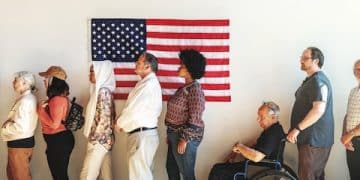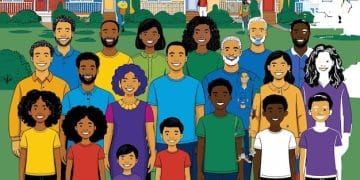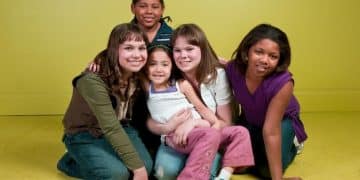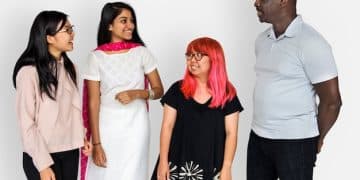Aging in America: Reshaping Retirement and Elder Care Attitudes
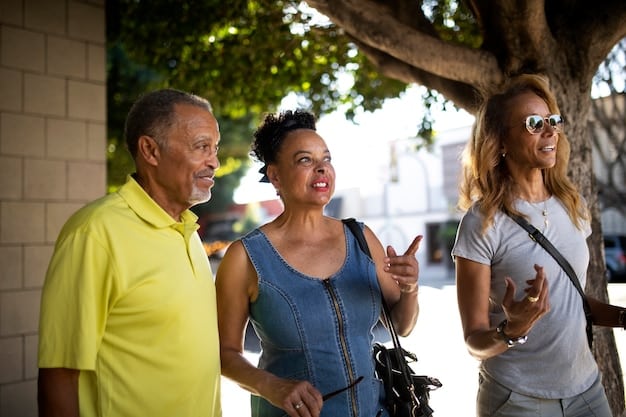
The aging of the US population is significantly impacting cultural perspectives on retirement and elder care, driving shifts in expectations around post-work life, family responsibilities, and the support systems needed for older adults to thrive.
The United States is experiencing a demographic shift, with a rapidly aging population. This change is not merely a statistical trend; it’s profoundly reshaping cultural attitudes towards retirement and elder care, influencing everything from personal financial planning to societal support systems for seniors.
The Evolving Definition of Retirement
Retirement is no longer seen as a complete cessation of work and activity. Instead, many older Americans are redefining what retirement means to them, challenging traditional notions of aging and leisure.
The Rise of Encore Careers
More and more retirees are seeking “encore careers”—jobs that offer purpose and fulfillment, often in fields different from their previous professions. This shift is driven by a desire to stay active, contribute to society, and supplement retirement income.
Phased Retirement Approaches
Phased retirement, where individuals gradually reduce their working hours over time, is gaining popularity. This approach allows for a smoother transition into retirement, providing both continued income and a sense of structure.
- Staying mentally and physically active is essential for healthy aging.
- Encore careers provide a sense of purpose and social connection.
- Financial considerations often drive the desire for continued employment.

The evolving definition of retirement reflects a broader cultural shift towards valuing continuous learning, engagement, and purpose throughout life. It underscores the importance of flexible and adaptable retirement planning.
Shifting Family Dynamics and Elder Care
The increasing number of older adults is placing new demands on family members who often serve as primary caregivers. This has led to changes in family dynamics and expectations regarding elder care responsibilities.
The Sandwich Generation
Many adults find themselves in the “sandwich generation,” caring for both their aging parents and their own children. This can create significant stress and financial strain.
Increased Reliance on Professional Care
As families become more geographically dispersed and demands on caregivers increase, there’s a growing reliance on professional elder care services, including home health aides and assisted living facilities.
- The emotional and financial toll on family caregivers can be substantial.
- Affordable and accessible elder care options are crucial for supporting aging individuals and their families.
- Open communication and shared decision-making are vital for navigating elder care challenges.
The changing demographics are impacting family structures, necessitating a reevaluation of caregiving roles and a greater emphasis on professional support for seniors.
Technological Innovations in Elder Care
Technology is playing an increasingly important role in supporting older adults and enhancing their quality of life, offering innovative solutions for monitoring health, promoting social connection, and facilitating independent living.
Telehealth and Remote Monitoring
Telehealth services and remote monitoring devices allow healthcare providers to track patients’ vital signs and health conditions from a distance, enabling timely interventions and reducing the need for frequent in-person visits.
Smart Home Technologies
Smart home technologies, such as voice-activated assistants and automated lighting systems, can make homes safer and more accessible for older adults with mobility limitations.
- Technology can empower seniors to maintain their independence and age in place.
- Data privacy and security are critical considerations when using technology for elder care.
- Training and support are necessary to ensure that older adults can effectively use new technologies.

Technological advancements are transforming elder care, offering new possibilities for promoting health, safety, and social engagement among older adults. However, it’s essential to address issues of accessibility and digital literacy.
The Financial Landscape of Retirement and Elder Care
The financial aspects of retirement and elder care are becoming increasingly complex, with longer life expectancies and rising healthcare costs posing significant challenges for individuals and families.
The Importance of Long-Term Care Planning
Planning for long-term care needs is essential, as these costs can quickly deplete retirement savings. Long-term care insurance, though expensive, can provide a financial safety net.
The Role of Governmental Programs
Social Security and Medicare are crucial safety nets for older Americans, but they may not be sufficient to cover all retirement and elder care expenses. Understanding these programs and their limitations is vital.
- Financial literacy and planning are essential for a secure retirement.
- Exploring various funding options, such as reverse mortgages and annuities, may be beneficial.
- Seeking professional financial advice is advisable to navigate the complexities of retirement and elder care financing.
The financial burdens associated with retirement and elder care require proactive planning, informed decision-making, and a comprehensive understanding of available resources and support systems.
Cultural Re-evaluation of Aging and Ageism
Societal attitudes towards aging are slowly shifting, with a growing recognition of the value and contributions of older adults. However, ageism remains a pervasive issue.
Challenging Negative Stereotypes
Efforts to challenge negative stereotypes about aging and promote positive images of older adults are gaining momentum. This includes showcasing seniors who are actively engaged in their communities and pursuing their passions.
The Focus on Intergenerational Connections
Programs that foster intergenerational connections, such as mentoring opportunities and shared learning experiences, are helping to bridge the gap between younger and older generations.
- Combating ageism requires a conscious effort to challenge biases and promote inclusivity.
- Celebrating the wisdom and experience of older adults enriches society as a whole.
- Creating age-friendly communities benefits people of all ages.
A cultural shift towards valuing aging and dismantling ageist attitudes is essential for creating a more equitable and supportive society for people of all ages.
Policy Implications and Societal Support
The aging of the US population has significant policy implications, requiring governments and communities to develop innovative solutions to support older adults and address their unique needs.
Expanding Access to Affordable Housing
Ensuring access to affordable and age-friendly housing is crucial for enabling older adults to remain independent and connected to their communities.
Investing in Community-Based Services
Investing in community-based services, such as senior centers and transportation programs, can help older adults maintain their social connections and access essential resources.
- Policies that promote healthy aging and prevent chronic diseases are essential for reducing healthcare costs.
- Collaboration between government agencies, non-profit organizations, and the private sector is vital for addressing the challenges of an aging population.
- Advocacy and awareness campaigns can help to raise public awareness of the needs of older adults.
Addressing the challenges and opportunities presented by an aging population requires comprehensive policy changes, strategic investments, and a collaborative approach that prioritizes the well-being of older adults.
| Key Aspect | Brief Description |
|---|---|
| 👴 Evolving Retirement | Retirement is being redefined with encore careers and phased approaches as seniors stay active. |
| 🏡 Elder Care Shifts | Family and professional care roles are changing due to increased needs and dispersed families. |
| 📱 Tech in Aging | Technology offers solutions for health monitoring and maintaining connections for older adults. |
| 💰 Financial Planning | Long-term care planning and understanding government programs are vital for financial security. |
Frequently Asked Questions
Attitudes towards retirement are shifting from a complete cessation of work to a phase of continued engagement, learning, and contribution. More seniors are exploring encore careers and phased retirement options.
The sandwich generation refers to individuals who are simultaneously caring for their aging parents and their own children. This situation often creates significant stress and financial strain due to the dual caregiving responsibilities.
Technology is transforming elder care through telehealth, remote monitoring, and smart home devices. These innovations help older adults maintain independence, monitor their health, and stay connected with loved ones.
Financial planning is vital because retirement and elder care costs can be substantial. Effective financial planning helps individuals prepare for long-term care expenses and secure their financial future.
Combating ageism involves challenging negative stereotypes, promoting positive images of older adults, and fostering intergenerational connections. Celebrating the wisdom and experience of seniors enriches society and promotes inclusivity.
Conclusion
The aging of the US population is driving a profound transformation in cultural attitudes towards retirement and elder care. This shift necessitates a re-evaluation of societal norms, family dynamics, technological advancements, and policy frameworks to ensure that older adults can live fulfilling and dignified lives.
